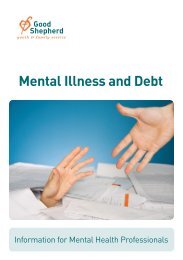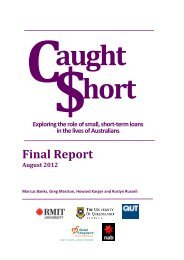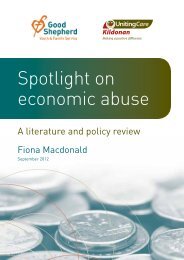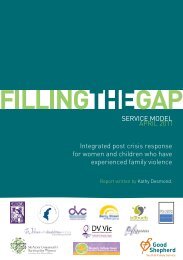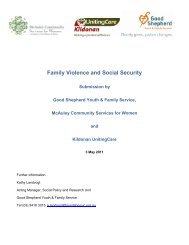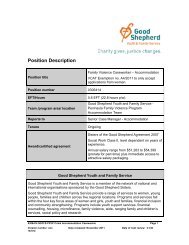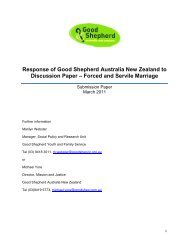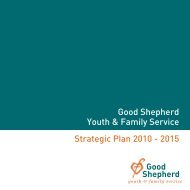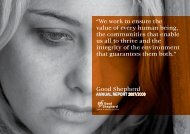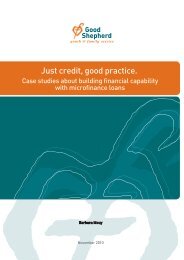Spotlight on economic abuse - Good Shepherd Youth & Family ...
Spotlight on economic abuse - Good Shepherd Youth & Family ...
Spotlight on economic abuse - Good Shepherd Youth & Family ...
You also want an ePaper? Increase the reach of your titles
YUMPU automatically turns print PDFs into web optimized ePapers that Google loves.
also parents and children and paid staff who were carers of the pers<strong>on</strong> they <strong>abuse</strong>d (Office<br />
of the Public Advocate 2010). A British study of women with disabilities by Hague et al.<br />
(2008) identified examples of ec<strong>on</strong>omic <strong>abuse</strong> by intimate partners that included women<br />
being denied m<strong>on</strong>ey for medicines and for essential pers<strong>on</strong>al needs related to impairment<br />
and of abusive partners taking over total c<strong>on</strong>trol of the finances of women who were highly<br />
dependent. Similarly Smith and Hilt<strong>on</strong> (2008) report women with disabilities being prevented<br />
from going to work by partners and other family members who for example, refused to assist<br />
with daily routines such as grooming, damaged communicati<strong>on</strong> devices or removed batteries<br />
from electric wheelchairs.<br />
Ec<strong>on</strong>omic <strong>abuse</strong> in the form of ‘humbugging’ has been identified as a particular problem for<br />
people in some indigenous communities (ALRC/NSWLRC 2010, p. 214; Bryant & Willis<br />
2008). Humbugging is the practice of demanding m<strong>on</strong>ey or other material resources from<br />
relatives, it is often enforced by threatening behaviour (ALRC/NSWLRC 2010, p. 214) or<br />
through ‘trickery and deceit’ and it is most comm<strong>on</strong>ly perpetrated by young men (NCRVAWV<br />
2009, p. 189). It can leave people with little or no m<strong>on</strong>ey for food and other essentials and,<br />
while humbugging may occur throughout communities, the most comm<strong>on</strong> victims are<br />
women. Bryant and Willis (2008, p. 6) note that while the extent of ec<strong>on</strong>omic <strong>abuse</strong> in<br />
indigenous communities has not been quantified “its physical, emoti<strong>on</strong>al and mental effects<br />
are potentially devastating”. While there may be particular difficulties identifying and<br />
addressing humbugging in the c<strong>on</strong>text of kinship and family obligati<strong>on</strong>s and practices which<br />
promote sharing, no relevant research literature was found <strong>on</strong> this.<br />
Other groups may be at increased risk of violence due to facing cultural or language barriers<br />
to seeking help (B<strong>on</strong>ar & Roberts 2006 cited by Dimopolous 2011). Low English language<br />
skills can be a barrier to accessing informati<strong>on</strong> and services while cultural norms in some<br />
communities may create barriers for some women. In a discussi<strong>on</strong> of elder <strong>abuse</strong> Wainer et<br />
al. (2010, p. 10) make the point that “the management of m<strong>on</strong>ey and intergenerati<strong>on</strong>al asset<br />
transfer within families is culturally bound and draws <strong>on</strong> deeply held values about<br />
appropriate behaviour and resp<strong>on</strong>sibilities between generati<strong>on</strong>s”. This has a wider<br />
applicability to domestic and family violence and may be a factor increasing risk in some age<br />
groups and for some groups from particular ethnic and cultural backgrounds. However, it<br />
needs to be remembered that culturally and linguistically diverse (CALD) groups are not<br />
homogeneous and cannot be treated as such, a point which has been stressed by<br />
researchers (Dimopoulos 2011; Morgan & Chadwick 2009).<br />
A group of migrant women who are particularly vulnerable to being trapped in situati<strong>on</strong>s of<br />
violence and <strong>abuse</strong> are women who are in relati<strong>on</strong>ships with citizens or permanent residents<br />
of Australia but who themselves are awaiting permanent residency (Pham 2011). The<br />
Australian Domestic & <strong>Family</strong> Violence Clearinghouse’s (ADFVC) recent qualitative study<br />
included several women whose partners had attempted to sabotage their migrati<strong>on</strong><br />
applicati<strong>on</strong>s or make it difficult for them to apply for work visas or residency (Braaf & Barrett<br />
Meyering 2011). Vulnerability for women in these circumstances may also be high because<br />
of social isolati<strong>on</strong> and lack of alternative means of financial support, including inability to take<br />
up paid work due to language and skill barriers or visa restricti<strong>on</strong>s and lack of eligibility for<br />
income support payments.<br />
Women living in rural and remote areas, including women in indigenous communities, may<br />
be less likely to seek help for domestic violence. Drawing together the findings from a<br />
number of Australian studies, Mitchell (2011) identifies the ideology of self-reliance, informal<br />
sancti<strong>on</strong>s and social c<strong>on</strong>trol as factors in this al<strong>on</strong>g with traditi<strong>on</strong>al gender roles as risk<br />
factors. Women in rural and remote areas may also find it harder to seek help or leave a<br />
violent relati<strong>on</strong>ship. Morgan and Chadwick (2009) also review relevant Australian literature<br />
and they identify the barriers as isolati<strong>on</strong> and a lack of services (including lack of access to<br />
services that women perceive as c<strong>on</strong>fidential and as providing an<strong>on</strong>ymity).<br />
17



